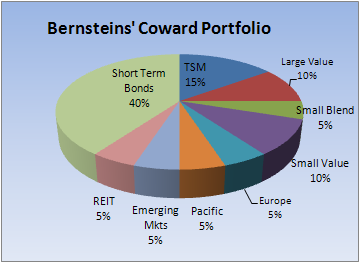harry06880
Dryer sheet wannabe
Hi Guys&Gals
Have read quite a few books suggested here, and need just advice on my Retirement Portfolio. I have split my portfolio into 55/45 equities and bonds I am 56 years old and retired Aug 31 2012
I am mostly in cash right now and will allocate via DCA every quarter to take advantage of some averaging over the next 2 years to accounts below. I have enough cash to cover three years expenses so I'm ok there.
Target allocation
Vanguard Taxable
VTSAX Total Stock Market 55%
VMAX Mid Cap Value 5%
VSIAX Small Cap Value 5%
VFWAX FTSE all World ex US 15%
Cash 20%( to take advantage of any serious dips)
IRA Account
VBTLX Total Bond Market 75%
VIPSX Inflation Protected sec 15 %
VGSLX US Reits 10%
I have put the reits in my IRA as I am out of room in my Taxable accounts.
I just need some advice or what others have done with regards to below questions
1) The total stock market funds are a little light on value stocks in the MID and Small value area, has anyone else made adjustments added as I did above
2) The Inflation Protected securities in my IRA, I am wondering if this is the best choice from Vanguard there are a couple of Tip funds.
I am forever thankful for all the help I have received here
Thanks Harry
Have read quite a few books suggested here, and need just advice on my Retirement Portfolio. I have split my portfolio into 55/45 equities and bonds I am 56 years old and retired Aug 31 2012
I am mostly in cash right now and will allocate via DCA every quarter to take advantage of some averaging over the next 2 years to accounts below. I have enough cash to cover three years expenses so I'm ok there.
Target allocation
Vanguard Taxable
VTSAX Total Stock Market 55%
VMAX Mid Cap Value 5%
VSIAX Small Cap Value 5%
VFWAX FTSE all World ex US 15%
Cash 20%( to take advantage of any serious dips)
IRA Account
VBTLX Total Bond Market 75%
VIPSX Inflation Protected sec 15 %
VGSLX US Reits 10%
I have put the reits in my IRA as I am out of room in my Taxable accounts.
I just need some advice or what others have done with regards to below questions
1) The total stock market funds are a little light on value stocks in the MID and Small value area, has anyone else made adjustments added as I did above
2) The Inflation Protected securities in my IRA, I am wondering if this is the best choice from Vanguard there are a couple of Tip funds.
I am forever thankful for all the help I have received here
Thanks Harry
Last edited:

